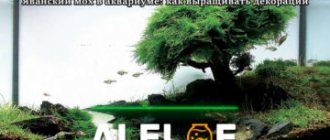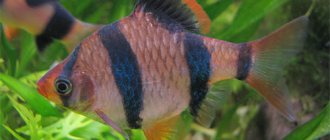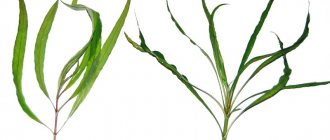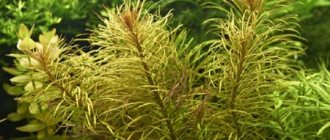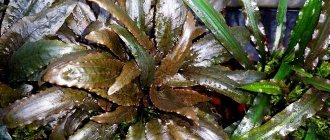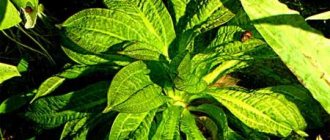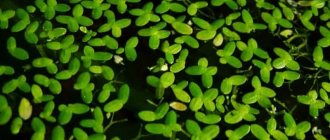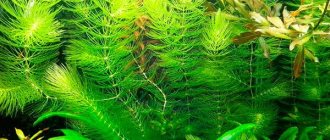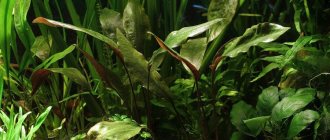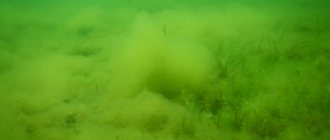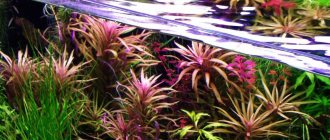Description
| Kingdom | Plants |
| Type | Flowering |
| Class | Dicotyledons |
| Squad | Umbelliferae |
| Family | Araliaceae |
| Genus | Pennywort |
Hydrocotyle tripartita or Hydrocotyle tripartita belongs to the genus of the Araliaceae family. There are over 90 different species in the genus. All of them are low herbaceous perennials native to the Southern Hemisphere.
Close relatives are the vertical and white-headed hydrocotyls.
- Vertical hydrocotyla, also known as “water navel”, also known as Whorled foliage, differs from tripartita in the rounded shape of its leaves with wavy edges.
- The white-headed hydrocotyla has leaves that strongly resemble house geraniums. Only pubescence is absent. This species grows very quickly, filling large spaces, trying to climb to the surface of the water.
Appearance
Hydrocortila tripartita, also known as Tripartite scutum, is a very attractive compact plant that forms lush thickets. It is considered a ground cover, but can easily float in water without rooting in the ground.
It consists of many tendrils (creeping stems) on which whorls (nodules) are located. From each node grows from 1 to 3 small leaves. They grow vertically on a petiole up to 30 mm long. The shape of the leaves resembles meadow clover, dividing into three lobes. For this reason, the shield leaf was called tripartite.
Under favorable conditions, hydrocotyle turns a rich, bright green color. It can reach 1 dm in height, the leaf diameter rarely exceeds 40 mm.
The root system is very weak, the roots appear from whorls. Only those that are close to it take root in the soil. All others swim freely, receiving nutrition directly from the water.
Kinds
The hydrocotyle plant has no subspecies or breeding forms.
Habitat in nature
Hydrocortyle grows naturally in tropical regions of Asia. It was first discovered in Japan more than 100 years ago.
Trifid foxtail prefers lakes and ponds with stagnant water or slowly flowing rivers. It can only grow in warm bodies of water with constant temperature and fresh water.
Benefits for the aquarium
The main function of tripartita in an aquarium is decorative. At your request, it can form dense thickets in the form of a ground cover carpet or a beautiful ball. Or, on the contrary, grow like rare bushes or lawns. This is why Hydrocortyla tripartita is so valued in aquascapes.
Cottonwort is considered a mid-ground plant, but if desired, it can be planted in the front. It can be allowed to spread along the bottom, decorate the corners of the aquarium, and be used as a frame for decorations. In an aquascape it can be used to create focal points.
Hydrocotyle leucocephala
Umbrella family - Apiaceae. Homeland - tropical regions of South America.
Also known as white-headed shieldwort. An original long-stemmed plant with light green rounded leaves. It can be grown either floating on the surface of the water or rooted in the ground under water.
Hydrocotyla planted in the background of the aquarium looks very beautiful. It can be grown in an aquarium of any size. The plant is undemanding in terms of maintenance conditions, which is why it enjoys well-deserved popularity among amateurs.
Hydrocotyla is more suitable for a tropical aquarium. The plant can be kept in a moderately warm body of water, but its growth will slow down. The optimal water temperature for hydrocotyla is 22 – 28 °C. Hardness and active reaction of water do not play a significant role. The plant feels satisfactory in both acidic and alkaline environments (pH 6-8 is preferred). Regular water changes are necessary, since the plant quickly degrades in old water that has not been changed for a long time.
Hydrocotyla is very demanding regarding lighting conditions. Even with slight shading, the plant quickly decreases in size and dies. Natural light is very useful for him. The plant in the aquarium (in the water column) should be covered from direct sunlight. Fluorescent and incandescent lamps are suitable for artificial lighting. The power of fluorescent lamps should be 0.4 - 0.5 W per 1 liter of aquarium volume, the power of incandescent lamps should be approximately three times higher. When using incandescent lamps, care must be taken, as they can burn the leaves of shoots floating on the surface of the water. The combination of illuminators does not provide a significant improvement in growth. The duration of daylight should be at least 12 hours.
Difficulty in content
Aquarists have very different opinions on this matter. Some say that hydrocortyle is an absolutely unpretentious plant that can live in any conditions. Others argue that for the normal development of the shield leaf, a special environment and continuous care are needed.
The truth is usually in the middle. Hydrocortyl tripartita, of course, will not grow like a weed, but it will not require special conditions either.
The main difficulty lies in the constant purification of water. Any contaminants will settle on the leaves, forming a dense coating that prevents the plant from “breathing.” This can lead not only to illness, but also to the death of tripartita.
Keeping in an aquarium
Water parameters.
Soft water with a neutral reaction is ideal for breeding rosemary.
- Temperature: optimal 23-27°, minimum 20°, maximum 30°.
- Hardness 1-9 dGH.
- pH 6.8-7.1.
Aquarium dimensions.
You can use a container of any size, but stinkwort looks best in large aquariums where it has the opportunity to grow. Any form of housing is possible.
Priming.
A delicate plant should not be planted in a rough substrate. Large stones with sharp edges can damage stunted roots and fragile stems. For hydrocortyle, fine-grained sand or small rolled stones such as sea pebbles are suitable.
Lighting.
With a lack of light, the plant begins to stretch, wither and lose color saturation. In order for the rosemary to develop normally, it should be provided with bright light of 0.6-1.4 W/l and a light period of at least 9 hours a day.
Aeration.
The carbon dioxide supply should be 7-10 mg/l.
Filtration.
It is recommended to install a sufficiently powerful filter for cleaning. Any dirt negatively affects the condition of the plant. Regular water replacement is also a mandatory procedure when maintaining scutellum. Water should be replaced by a third of the volume every 9-12 days.
Fertilizers.
Hydrocortyle tripartita grows quickly, extracting nutrients from water, and therefore needs additional nutrition. It is recommended to add liquid fertilizers to the aquarium water approximately once every 8-10 days. Special mineral complexes are quite suitable.
How to plant a plant?
It makes no sense to bury hydrocotyl in the ground. It is enough to simply place the bush on the bottom and gently press it with brackets or a pebble so that it does not float up.
Compatibility with other aquarium inhabitants
Shield leaf is not poisonous, so it does not pose a threat to neighbors. As it grows, it can block the light of smaller plants in the foreground, and it itself can suffer from taller algae.
List of compatible inhabitants.
- Small shrimp
- Predatory fish
- Danio
- Most plants
- Small barbs
- Labyrinth varieties
- Viviparous platies, guppies, mollies
- Labeo
- Botsiya
- Angelfish
List of incompatible inhabitants.
- Malawian and African cichlids
- Tilapia
- Goldfish
- Large catfish
- Tetragonopterus
- Large barbs
- Large characin fish
Diseases
Stopping development and growth.
Occurs due to a lack of carbon dioxide in the aquarium or a change in the acid-base balance. It is necessary to increase the CO2 supply and replace a third of the water with fresh water with the correct pH or transplant the plant from another aquarium.
Holes on leaves.
Holes of different sizes and shapes appear on the leaves out of nowhere, then the affected leaf begins to turn yellow and disappears completely.
The reason is a lack of useful elements, in particular potassium and phosphorus. Feed your plants with mineral complexes more often.
Decrease in the decorative value of scutellum.
Do the stems become very elongated, the leaves become smaller, the color changes from rich green to pale and sickly? The plant is sorely lacking light!
Hydrocotyla is fading.
If the plant loses turgor, begins to wither, the edges of the leaves become frayed and full of holes, the environment is completely unsuitable for it.
Check all environmental parameters and chemical composition to identify the source of the problem.
White coating on the leaves.
Most likely, lime settles on the leaf blades due to a lack of carbon dioxide in the aquarium.
The leaves take on a reddish or yellow tint.
Thus, the plant signals a lack of nitrogen compounds and sulfur. Introduce these substances into the squid's diet and the problem will be eliminated.
Only the edges of the leaves turn yellow.
With a serious lack of an element such as calcium.
Lifespan
Trififolia is a perennial. The plant can live over 5 years.
average price
The cost of Hydrocortyle varies from 110 to 190 rubles depending on the area. You can purchase this plant at a regular pet store or in online stores.
Compatibility
Hydrocotyla is a non-toxic green, so it can be safely planted in an aquarium with fish and other inhabitants. Do not combine tall vegetation with wide leaves with rosemary, because hydrocotyle will not have enough light and its color will fade. The shield leaf itself is capable of blocking the light with low-growing greenery. Vegetation of medium height is best suited for joint planting:
- Ammania senegalese.
- Aponogeton curly.
- Common cabomba.
- Cryptocoryne Hertel.
- Horny fern.
Kinds
Today there are many varieties of this plant. However, the following types are especially popular:
Tripartita
It is often classified as ground cover plants. Of course, it can provide good growth in the lower part of the aquarium. However, in its essence, the type of tripartite is not such. “Ground cover” is characterized by the fact that it sends out stems along the ground and takes root on its own. This hydrocoil does not cling to stones. Only those parts that are near it are buried in the substrate. The rest will strive for thicker water, because that’s where they feel best. This species differs from others in its miniature size. The leaves grow to only 1.5 cm. They are on a small stalk up to 3 cm;
White-headed
It has larger and rounded leaves. It can also either float around the aquarium or be rooted. Looks impressive towards the back of the aquascape. However, it is better not to plant it and leave it near the surface, where the plant will grow roots and the leaves will begin to emerge above the water, creating a thick floating carpet;
Hydrocotyle verticillata
Umbrella family - Apiaceae. Homeland - southern and eastern regions of North America, Central America.
Among aquarium enthusiasts, hydrocotyla is known as the “water navel.” A very beautiful and original plant with round leaves of bright green color, reaching 3 cm in diameter, on cuttings up to 7 - 10 cm high, extending from a long creeping stem. In the aquarium it is placed in the foreground. Due to certain maintenance difficulties, the plant is relatively unpopular among aquarists. In an aquarium it can grow throughout the year.
Hydrocotyla is more suitable for a moderately warm aquarium, but can also grow in a tropical pond. The most suitable temperature is 20 – 24 °C. It is desirable to have soft water with a neutral or slightly acidic reaction, but hydrocotyla can also be kept in moderately hard water with a slightly alkaline reaction. In any case, the plant in the aquarium develops rather slowly.
The lighting should be bright, both natural and artificial light is suitable. Diffused daylight from a window is usually not enough for hydrocotyle; it needs sunlight. When using artificial lighting in a tall aquarium, additional side lighting should be created. For overhead lighting, fluorescent lamps with a power of at least 0.5 W per 1 liter of volume are used. Daylight hours are 12–14 hours.
The soil must be nutritious. The root system of the plant is very delicate; it needs a substrate consisting of small particles. Therefore, it is best to use sand for the soil, laying it in a layer 2-3 cm thick. The natural siltation of the soil in the aquarium is quite enough to feed the plant. Additional mineral fertilizing may not be necessary.
The “water navel” grows satisfactorily only in a paludarium. The plant should be planted in marshy soil consisting of clay, peat and sand, to which garden soil can be added. It is also useful to add sludge taken from the aquarium to the soil.
Hydrocotyla is propagated by dividing the rhizome. For planting in a paludarium, you can use small cuttings with 4-5 leaves. Only a fairly strong plant can be placed in an aquarium, having about a dozen leaves and gradually adapted to the conditions of the aquarium, since in deep water the plant freezes for a long time after transplantation.
The plant must also be transferred from water to air gradually, very slowly reducing the water level.
Variations and forms of the plant
The white-headed hydrocotyl does not have its own forms or subspecies. However, in aquariums you can find related species similar in appearance.
- Buttercup. A fast-growing plant that is grown mainly in paludariums and along the banks of ponds. Unlike the white-headed hydrocotyl, it can tolerate temperatures dropping to almost zero degrees Celsius.
- Common shieldwort. A plant with a wide range of uses. It can be successfully planted in both tropical and cold-water aquariums, as well as along the banks of ponds and in paludariums. When grown in warm water, it can fill almost the entire aquarium in a few weeks.
